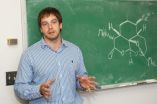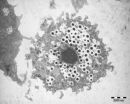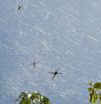(Press-News.org)
VIDEO:
The movie shows the injector firing into open air without a skin or gel target. The jet, which is approximately the diameter of a human hair, seems dispersed but a...
Click here for more information.
WASHINGTON, Sept. 13—From annual flu shots to childhood immunizations, needle injections are among the least popular staples of medical care. Though various techniques have been developed in hopes of taking the "ouch" out of injections, hypodermic needles are still the first choice for ease-of-use, precision, and control.
A new laser-based system, however, that blasts microscopic jets of drugs into the skin could soon make getting a shot as painless as being hit with a puff of air.
The system uses an erbium-doped yttrium aluminum garnet, or Er:YAG, laser to propel a tiny, precise stream of medicine with just the right amount of force. This type of laser is commonly used by dermatologists, "particularly for facial esthetic treatments," says Jack Yoh, professor of mechanical and aerospace engineering at Seoul National University in South Korea, who developed the device along with his graduate students. Yoh and his team describe the injector in a paper published today in the Optical Society's (OSA) journal Optics Letters.
The laser is combined with a small adaptor that contains the drug to be delivered, in liquid form, plus a chamber containing water that acts as a "driving" fluid. A flexible membrane separates these two liquids. Each laser pulse, which lasts just 250 millionths of a second, generates a vapor bubble inside the driving fluid. The pressure of that bubble puts elastic strain on the membrane, causing the drug to be forcefully ejected from a miniature nozzle in a narrow jet a mere 150 millionths of a meter (micrometers) in diameter, just a little larger than the width of a human hair.
"The impacting jet pressure is higher than the skin tensile strength and thus causes the jet to smoothly penetrate into the targeted depth underneath the skin, without any splashback of the drug," Yoh says. Tests on guinea pig skin show that the drug-laden jet can penetrate up to several millimeters beneath the skin surface, with no damage to the tissue. Because of the narrowness and quickness of the jet, it should cause little or no pain, Yoh says. "However, our aim is the epidermal layer," which is located closer to the skin surface, at a depth of only about 500 micrometers. This region of the skin has no nerve endings, so the method "will be completely pain-free," he says.
In previous studies, the researchers used a laser wavelength that was not well absorbed by the water of the driving liquid, causing the formation of tiny shock waves that dissipated energy and hampered the formation of the vapor bubble. In the new work, Yoh and colleagues use a laser with a wavelength of 2,940 nanometers, which is readily absorbed by water. This allows the formation of a larger and more stable vapor bubble "which then induces higher pressure on the membrane," he explains. "This is ideal for creating the jet and significantly improves skin penetration."
Although other research groups have developed similar injectors, "they are mechanically driven," using piston-like devices to force drugs into the skin, which gives less control over the jet strength and the drug dosage, Yoh says. "The laser-driven microjet injector can precisely control dose and the depth of drug penetration underneath the skin. Control via laser power is the major advancement over other devices, I believe."
Yoh is now working with a company to produce low-cost replaceable injectors for clinical use. "In the immediate future, this technology could be most easily adopted to situations where small doses of drugs are injected at multiple sites," he says. "Further work would be necessary to adopt it for scenarios like mass vaccine injections for children."
INFORMATION:
Paper: "Er:YAG laser pulse for small-dose splashback-free microjet transdermal drug delivery," Optics Letters, Vol. 37, Issue 18, pp. 3894-3896 (2012). http://www.opticsinfobase.org/ol/abstract.cfm?uri=ol-37-18-3894
EDITOR'S NOTE: High-resolution images and a video clip are available to members of the media upon request. Contact Angela Stark, astark@osa.org.
About Optics Letters
Published by the Optical Society (OSA), Optics Letters offers rapid dissemination of new results in all areas of optics with short, original, peer-reviewed communications. Optics Letters covers the latest research in optical science, including optical measurements, optical components and devices, atmospheric optics, biomedical optics, Fourier optics, integrated optics, optical processing, optoelectronics, lasers, nonlinear optics, optical storage and holography, optical coherence, polarization, quantum electronics, ultrafast optical phenomena, photonic crystals, and fiber optics. This journal, edited by Alan E. Willner of the University of Southern California and published twice each month, is where readers look for the latest discoveries in optics. Visit www.OpticsInfoBase.org/OL.
About OSA
Uniting more than 180,000 professionals from 175 countries, the Optical Society (OSA) brings together the global optics community through its programs and initiatives. Since 1916 OSA has worked to advance the common interests of the field, providing educational resources to the scientists, engineers and business leaders who work in the field by promoting the science of light and the advanced technologies made possible by optics and photonics. OSA publications, events, technical groups and programs foster optics knowledge and scientific collaboration among all those with an interest in optics and photonics. For more information, visit www.osa.org.
Laser-powered 'needle' promises pain-free injections
Optical technology gives a sci-fi twist to traditional medicine
2012-09-13
ELSE PRESS RELEASES FROM THIS DATE:
IU chemist develops new synthesis of most useful, yet expensive, antimalarial drug
2012-09-13
BLOOMINGTON, Ind. -- In 2010 malaria caused an estimated 665,000 deaths, mostly among African children. Now, chemists at Indiana University have developed a new synthesis for the world's most useful antimalarial drug, artemisinin, giving hope that fully synthetic artemisinin might help reduce the cost of the live-saving drug in the future.
Effective deployment of ACT, or artemisinin-based combination therapy, has been slow due to high production costs of artemisinin. The World Health Organization has set a target "per gram" cost for artemisinin of 25 cents or less, but ...
Study of giant viruses shakes up tree of life
2012-09-13
CHAMPAIGN, Ill. — A new study of giant viruses supports the idea that viruses are ancient living organisms and not inanimate molecular remnants run amok, as some scientists have argued. The study reshapes the universal family tree, adding a fourth major branch to the three that most scientists agree represent the fundamental domains of life.
The new findings appear in the journal BMC Evolutionary Biology.
The researchers used a relatively new method to peer into the distant past. Rather than comparing genetic sequences, which are unstable and change rapidly over time, ...
Scientists use sound waves to levitate liquids, improve pharmaceuticals
2012-09-13
It's not a magic trick and it's not sleight of hand – scientists really are using levitation to improve the drug development process, eventually yielding more effective pharmaceuticals with fewer side effects.
Scientists at the U.S. Department of Energy's (DOE) Argonne National Laboratory have discovered a way to use sound waves to levitate individual droplets of solutions containing different pharmaceuticals. While the connection between levitation and drug development may not be immediately apparent, a special relationship emerges at the molecular level.
At the molecular ...
Increased dietary fructose linked to elevated uric acid levels and lower liver energy stores
2012-09-13
Obese patients with type 2 diabetes who consume higher amounts of fructose display reduced levels of liver adenosine triphosphate (ATP)—a compound involved in the energy transfer between cells. The findings, published in the September issue of Hepatology, a journal of the American Association for the Study of Liver Diseases, indicate that elevated uric acid levels (hyperuricemia) are associated with more severe hepatic ATP depletion in response to fructose intake.
This exploratory study, funded in part by grants from the National Institute of Diabetes and Digestive and ...
Poorest miss out on benefits, experience more material hardship, since 1996 welfare reform
2012-09-13
Although the federal government's 1996 reform of welfare brought some improvements for the nation's poor, it also may have made extremely poor Americans worse off, new research shows.
The reforms radically changed cash assistance—what most Americans think of as 'welfare'— by imposing lifetime limits on the receipt of aid and requiring recipients to work. About the same time, major social policy reforms during the 1990s raised the benefits of work for low-income families.
In the wake of these changes, millions of previous welfare recipients, largely single mothers, ...
Mutation breaks HIV's resistance to drugs
2012-09-13
The human immunodeficiency virus (HIV) can contain dozens of different mutations, called polymorphisms. In a recent study an international team of researchers, including MU scientists, found that one of those mutations, called 172K, made certain forms of the virus more susceptible to treatment. Soon, doctors will be able to use this knowledge to improve the drug regiment they prescribe to HIV-infected individuals.
"The 172K polymorphism makes certain forms of HIV less resistant to drugs," said Stefan Sarafianos, corresponding author of the study and researcher at MU's ...
UMD study shows exercise may protect against future emotional stress
2012-09-13
Moderate exercise may help people cope with anxiety and stress for an extended period of time post-workout, according to a study by kinesiology researchers in the University of Maryland School of Public Health published in the journal Medicine and Science in Sports and Exercise.
"While it is well-known that exercise improves mood, among other benefits, not as much is known about the potency of exercise's impact on emotional state and whether these positive effects endure when we're faced with everyday stressors once we leave the gym," explains J. Carson Smith, assistant ...
Snakes minus birds equals more spiders for Guam
2012-09-13
HOUSTON -- (Sept. 13, 2012) -- In one of the first studies to examine how the loss of forest birds is effecting Guam's island ecosystem, biologists from Rice University, the University of Washington and the University of Guam found that the Pacific island's jungles have as many as 40 times more spiders than are found on nearby islands like Saipan.
"You can't walk through the jungles on Guam without a stick in your hand to knock down the spiderwebs," said Haldre Rogers, a Huxley Fellow in Ecology and Evolutionary Biology at Rice and the lead author of a new study this ...
Under-twisted DNA origami delivers cancer drugs to tumors
2012-09-13
Scientists at Karolinska Institutet in Sweden describe in a new study how so-called DNA origami can enhance the effect of certain cytostatics used in the treatment of cancer. With the aid of modern nanotechnology, scientists can target drugs direct to the tumour while leaving surrounding healthy tissue untouched.
The drug doxorubicin has long been used as a cytostatic (toxin) for cancer treatment but can cause serious adverse reactions such as myocardial disease and severe nausea. Because of this, scientists have been trying to find a means of delivering the drug to the ...
Daily disinfection of isolation rooms reduces contamination of healthcare workers' hands
2012-09-13
CHICAGO (September 13, 2012) – New research demonstrates that daily cleaning of high-touch surfaces in isolation rooms of patients with Clostridium difficile (C. difficile) or methicillin-resistant Staphylococcus aureus (MRSA) significantly reduces the rate of the pathogens on the hands of healthcare personnel. The findings underscore the importance of environmental cleaning for reducing the spread of difficult to treat infections. The study is published in the October issue of Infection Control and Hospital Epidemiology, the journal of the Society for Healthcare Epidemiology ...
LAST 30 PRESS RELEASES:
Heart-brain connection: international study reveals the role of the vagus nerve in keeping the heart young
Researchers identify Rb1 as a predictive biomarker for a new therapeutic strategy in some breast cancers
Survey reveals ethical gaps slowing AI adoption in pediatric surgery
Stimulant ADHD medications work differently than thought
AI overestimates how smart people are, according to HSE economists
HSE researchers create genome-wide map of quadruplexes
Scientists boost cell "powerhouses" to burn more calories
Automatic label checking: The missing step in making reliable medical AI
Low daily alcohol intake linked to 50% heightened mouth cancer risk in India
American Meteorological Society announces Rick Spinrad as 2026 President-Elect
Biomass-based carbon capture spotlighted in newly released global climate webinar recording
Illuminating invisible nano pollutants: advanced bioimaging tracks the full journey of emerging nanoscale contaminants in living systems
How does age affect recovery from spinal cord injury?
Novel AI tool offers prognosis for patients with head and neck cancer
Fathers’ microplastic exposure tied to their children’s metabolic problems
Research validates laboratory model for studying high-grade serous ovarian cancer
SIR 2026 delivers transformative breakthroughs in minimally invasive medicine to improve patient care
Stem Cell Reports most downloaded papers of 2025 highlight the breadth and impact of stem cell research
Oxford-led study estimates NHS spends around 3% of its primary and secondary care budget on the health impacts of heat and cold in England
A researcher’s long quest leads to a smart composite breakthrough
Urban wild bees act as “microbial sensors” of city health.
New study finds where you live affects recovery after a hip fracture
Forecasting the impact of fully automated vehicle adoption on US road traffic injuries
Alcohol-related hospitalizations from 2016 to 2022
Semaglutide and hospitalizations in patients with obesity and established cardiovascular disease
Researchers ‘listen in’ to embryo-mother interactions during implantation using a culture system replicating the womb lining
How changing your diet could help save the world
How to make AI truly scalable and reliable for real-time traffic assignment?
Beyond fragmented markets: A new framework for efficient and stable ride-pooling
Can shape priors make road perception more reliable for autonomous driving?
[Press-News.org] Laser-powered 'needle' promises pain-free injectionsOptical technology gives a sci-fi twist to traditional medicine



